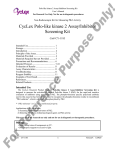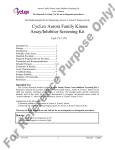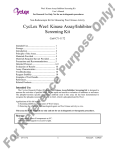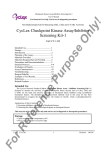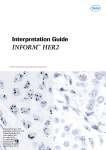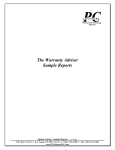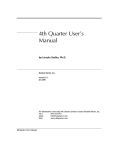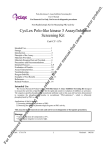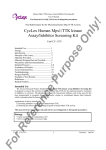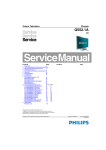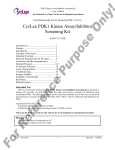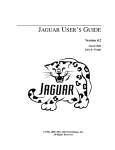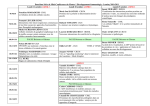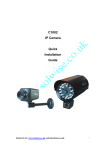Download For Reference Purpose Only!
Transcript
On Non-Radioisotopic Kit for Measuring Aurora-A kinase Activity ly ! Aurora-A kinase Assay/Inhibitor Screening Kit User’s Manual For Research Use Only, Not for use in diagnostic procedures Cat# CY-1165 en ce Pu rp Intended Use................................................ 1 Storage......................................................... 1 Introduction ................................................. 2 Principle of the Assay.................................. 3 Materials Provided ...................................... 4 Materials Required but not Provided .......... 4 Precautions and Recommendations............. 5 Detailed Protocol......................................... 6-9 Evaluation of Results .................................. 10 Assay Characteristics .................................. 10 Troubleshooting .......................................... 10 Reagent Stability ......................................... 10 Example of Test Results...............................11-12 References.....................................................13 Related Products............................................13 os e CycLex Aurora-A kinase Assay/Inhibitor Screening Kit Intended Use The CycLex Research Product CycLex Aurora-A kinase Assay/Inhibitor Screening Kit is designed to measure the activities of purified Aurora-A for the rapid and sensitive evaluation of inhibitors or activators. The phospho-serine specific monoclonal antibody used in this assay kit has been demonstrated to recognize the phospho-serine83 residue in Lats2, which is phosphorylated by Aurora-A. er Applications of this kit include: 1) Screening inhibitors or activators of Aurora-A. 2) Detecting the effects of pharmacological agents on Aurora-A activity. ef This assay kit is for research use only and not for use in diagnostic or therapeutic procedures. Storage rR • Upon receipt store all components at 4°C. • Don’t expose reagents to excessive light. Fo Cat#: CY-1165 1 Version#: 120420 On Introduction ly ! Aurora-A kinase Assay/Inhibitor Screening Kit User’s Manual For Research Use Only, Not for use in diagnostic procedures Pu rp os e Aurora-A is a key member of a closely related subgroup of serine/threonine kinases that belongs to the Drosophila aurora and Saccharomyces cerevisiae Ipl1 kinase family, and both are essential for chromosome segregation and centrosome functions (1-4). Aurora-A kinase has been shown to contribute to oncogenic transformation and is frequently overexpressed and amplified in many human tumor types (1, 2) . It has been reported that amplification of Aurora-A in approximately 12% of primary breast tumors, as well as in breast, ovarian, colon, prostate, neuroblastoma, and cervical cancer cell lines (1). Additionally, high expression of Aurora-A mRNA was detected in tumor cell lines without evidence of gene amplification. Ectopic expression of Aurora-A in mouse NIH 3T3 cells led to the appearance of abnormal centrosome number (amplification) and transformation in vitro. Finally, overexpression of Aurora-A in near-diploid human breast epithelial cells revealed similar centrosome abnormality, as well as induction of aneuploidy. These findings suggested that Aurora-A is a critical kinase-encoding gene, whose overexpression leads to centrosome amplification, chromosomal instability, and transformation in mammalian cells. Aurora-A belongs to a small family of mitotic serine/threonine kinases that regulate centrosome maturation, chromosome segregation, and cytokinesis. The mechanism behind the transforming activity of Aurora-A is not fully understood; however, the role of Aurora-A in regulating the centrosome cycle is likely responsible for its ability to transform cells. Aurora-A overexpression has been correlated with centrosome amplification, which can be a driving cause of genomic instability in tumor cells. In addition, recent work has demonstrated that Aurora-A plays an active function in promoting entry into mitosis by regulating local translation of centrosomal stored mRNA, such as cyclin B1. These recent findings implicate Aurora-A as an important regulator of both genomic integrity and cell cycle progression in cancer cells and suggest that Aurora-A is an attractive target for anticancer drug development. en ce Measurement of Aurora-A activity rR ef er The protocol generally regarded as most sensitive for the quantitative measurement of Aurora-A activity involves incubation of the Aurora-A sample with substrate, either a natural or synthetic polypeptide (such as Histone H3 substrate peptide), in the presence of Mg2+and 32P-labeled ATP. The reaction is terminated by "spotting" a sample onto a filter paper disc, followed by immersion in acid to precipitate the radiolabeled product. The filter papers are then washed extensively to remove unincorporated radiolabel and the radioactivity counted. While sensitive, this method is labor-intensive, generates hazardous radioactive waste and depends on a radioisotope of short half-life. It is particularly unsuitable when kinase assays are only performed on an infrequent basis. The CycLex Aurora-A kinase Assay/Inhibitor Screening Kit uses anti-phospho-Lats2 serine83 monoclonal antibody (ST-3B11) and peroxidase coupled anti-mouse IgG antibody as a reporter molecule in a 96-well ELISA format. This assay provides a non-isotopic, sensitive and specific method to measure the activities of Aurora-A kinase. Fo Cat#: CY-1165 2 Version#: 120420 On Principle of the Assay ly ! Aurora-A kinase Assay/Inhibitor Screening Kit User’s Manual For Research Use Only, Not for use in diagnostic procedures Pu rp os e The CycLex Research Product CycLex Aurora-A kinase Assay/Inhibitor Screening Kit is a single-site, semi-quantitative immunoassay for Aurora-A activity. Plates are pre-coated with a substrate corresponding to recombinant Lats2, which contains serine83 residues that can be phosphorylated by Aurora-A. The detector antibody specifically detects only the phosphorylated form of serine83 residue on Lats2. The CycLex Aurora-A kinase Assay/Inhibitor Screening Kit can be used to study the kinetics of a purified or partially purified Aurora-A as well as to screening Aurora-A inhibitor. To perform the test, the sample is diluted in Kinase Buffer, pipetted into the wells and allowed to phosphorylate the bound substrate following the addition of Mg2+ and ATP. The amount of phosphorylated substrate is measured by binding it with a ST-3B11, a anti-phospho- Lats2 serine83 monoclonal antibody, followed by binding with horseradish peroxidase conjugated anti-mouse IgG, which then catalyzes the conversion of the chromogenic substrate tetra-methylbenzidine (TMB) from a colorless solution to a blue solution (or yellow after the addition of stopping reagent). The color is quantitated by spectrophotometry and reflects the relative amount of Aurora-A activity in the sample. For kinetic analysis, the Aurora-A containing sample is added to the wells in a similar fashion and at varying times the reaction is stopped by the addition of the chelator, sodium ethylenediaminetetraacetate (EDTA) and the amount of phosphorylated substrate determined as before. Summary of Procedure Add 100 µL of sample to the wells Incubate for 30 min at 30°C en ce Wash the wells Add 100 µL of Anti-phospho-Lats2 serine83 monoclonal antibody (ST-3B11). Incubate for 30 min at room temp. Wash the wells Add 100 µL of HRP conjugated anti-mouse IgG er Incubate for 30 min at room temp. Wash the wells ef Add 100 µL of Substrate Reagent rR Add 100 µL of Stop Solution Fo Cat#: CY-1165 Measure absorbance at 450 nm 3 Version#: 120420 On Materials Provided ly ! Aurora-A kinase Assay/Inhibitor Screening Kit User’s Manual For Research Use Only, Not for use in diagnostic procedures All samples and standards should be assayed in duplicate. The following components are supplied and are sufficient for the one 96-well microtiter plate kit. os e Microplate: One microplate supplied ready to use, with 96 wells (12 strips of 8-wells) in a foil, zip-lock bag with a desiccant pack. Wells are coated with recombinant Lats2-N-ter as an Aurora-A substrate. 10X Wash Buffer: One bottle containing 100 mL of 10X buffer containing 2 %Tween®-20 Kinase Buffer: One bottle containing 20 mL of 1X buffer; used for Kinase Reaction Buffer and sample dilution. 20X ATP: Lyophilized ATP Na2 salt. rp Anti-Phospho-Lats2-S83 Monoclonal Antibody (ST-3B11): One vial containing 12 mL of anti-phospho- Lats2-S83 monoclonal antibody (ST-3B11). Ready to use. Pu HRP conjugated Anti-mouse IgG: One vial containing 12 mL of HRP (horseradish peroxidase) conjugated anti-mouse IgG. Ready to use. Substrate Reagent: One bottle containing 20 mL of the chromogenic substrate, tetra-methylbenzidine (TMB). Ready to use. Stop Solution: One bottle containing 20 mL of 1 N H2SO4. Ready to use. en ce Materials Required but not Provided rR ef er • Aurora-A positive control: Available from CycLex (Aurora-A positive control: Cat# CY-E1165, One vial containing 8 units/100 µL Aurora-A enzyme. Positive control should be added to the first well at 40 m units/well. For instance, diluted positive control 1:20, use 10 µL for 1 assay. (Unused Aurora-A enzyme should be stored in aliquots at -70°C.) • 10X Staurosporine (10 µM): Staurosporine is available from Sigma, Cat#. S-4400. 1 mM stock solution (DMSO) diluted 1:100 in Kinase Buffer. • Pipettors: 2-20 µL, 20-200 µL and 200-1000 µL precision pipettors with disposable tips. • Precision repeating pipettor • Wash bottle or multichannel dispenser for plate washing. • Microcentrifuge and tubes for sample preparation. • Vortex mixer • Plate reader capable of measuring absorbance in 96-well plates at dual wavelengths of 450 nm/540 nm. Dual wavelengths of 450/550 or 450/595 nm can also be used. The plate can also be read at a single wavelength of 450 nm, which will give a somewhat higher reading. • 500 or 1000 mL graduated cylinder • Reagent reservoirs • Deionized water of the highest quality • Disposable paper towels Fo Cat#: CY-1165 4 Version#: 120420 ly ! Precautions and Recommendations On Aurora-A kinase Assay/Inhibitor Screening Kit User’s Manual For Research Use Only, Not for use in diagnostic procedures • Store the Aurora-A enzyme at -70°C and the ATP at -20°C when not in use. Store all other components at 4°C. Do not expose reagents to excessive light. Avoid freeze/thaw cycles. • Allow all the components to come to room temperature before use. os e • All microplate strips that are not immediately required should be returned to the zip-lock pouch, which must be carefully resealed to avoid moisture absorption. • Do not use kit components beyond the indicated kit expiration date. • Use only the microtiter wells provided with the kit. rp • Rinse all detergent residue from glassware. • Use deionized water of the highest quality. Pu • Do not mix reagents from different kits. • The buffers and reagents used in this kit contain either sodium Kathon-CG as preservatives. Care should be taken to avoid direct contact with these reagents. • Do not mouth pipette or ingest any of the reagents. en ce • Do not smoke, eat, or drink when performing the assay or in areas where samples or reagents are handled. • Dispose of tetra-methylbenzidine (TMB) containing solutions in compliance with local regulations. • Avoid contact with Substrate Solution which contains hydrogen peroxide. • Avoid contact with Stop Solution which contains Sulfuric Acid. er • In case of contact with the Stop Solution and the Substrate Solution, wash skin thoroughly with water and seek medical attention, when necessary. • Biological samples may be contaminated with infectious agents. Do not ingest, expose to open wounds or breathe aerosols. Wear protective gloves and dispose of biological samples properly. rR ef • CAUTION: Sulfuric Acid is a strong acid. Wear disposable gloves and eye protection when handling Stop Solution. Fo Cat#: CY-1165 5 Version#: 120420 On Detailed Protocol ly ! Aurora-A kinase Assay/Inhibitor Screening Kit User’s Manual For Research Use Only, Not for use in diagnostic procedures os e The CycLex Aurora-A kinase Assay /Inhibitor Screening Kit is provided with removable strips of wells so the assay can be carried out on separate occasions using only the number of strips required for the particular determination. Since conditions may vary, running an aliquot of the appropriate Aurora-A positive control (Cat# CY-E1165), separately available from CycLex, should be included in each assay. Disposable pipette tips and reagent troughs should be used for all transfers to avoid cross-contamination of reagents or samples. Preparation of Working Solution 1. Prepare a working solution of Wash Buffer by adding 100 mL of the 10X Wash Buffer (provided) to 900 mL of ddH2O. Mix well. Store at 4°C for two weeks or -20°C for long-term storage. rp 2. Prepare 20X ATP Solution by adding 1.6 mL of ddH2O to the vial of 20X ATP (provided, lyophilized). Mix gently until dissolved. the Final concentration of the 20X ATP Solution should be 1.25 mM. Store the solution in small aliquots (e.g. 100 µL) at -20°C. Kinase Buffer (provided) 20X ATP (provided) 96 assays 10 assays 1 assay 9.5 mL 0.5 mL 950 µL 50 µL 95 µL 5 µL 10 mL 1000 µL 100 µL en ce Total Pu 3. Prepare Kinase Reaction Buffer (ATP plus) by mixing following reagents. You will need 80-90 µL of Kinase Reaction Buffer (ATP plus) per assay well. Mix well. Discard any unused Kinase Reaction Buffer (ATP plus) after use. Standard Assay 1. Remove the appropriate number of microtiter wells from the foil pouch and place them into the well holder. Return any unused wells to the foil pouch, refold, seal with tape and store at 4°C. er 2. Prepare all samples (diluted with Kinase Buffer. as needed). 3. Duplicate wells containing 10 µL of Aurora-A positive control (total 40 m units) should be included in each assay as a positive control for phosphorylation. ef 4. Begin the kinase reaction by addition of 90 µL Kinase Reaction Buffer per well, cover with plate sealer or lid, and incubate at 30°C for 30 minutes. rR 5. Wash wells five times with Wash Buffer making sure each well is filled completely. Remove residual Wash Buffer by gentle tapping or aspiration. 6. Pipette 100 µL of Anti-Phospho-Lats2-S83 Monoclonal Antibody ST-3B11 into each well, cover with plate sealer or lid, and incubate at room temperature (ca.25°C) for 30 minutes. Discard any unused antibody after use. Fo Cat#: CY-1165 6 Version#: 120420 On 7. Wash wells five times as same as in step 7. ly ! Aurora-A kinase Assay/Inhibitor Screening Kit User’s Manual For Research Use Only, Not for use in diagnostic procedures 8. Pipette 100 µL of HRP-conjugated Anti-mouse IgG into each well, cover with plate sealer or lid, and incubate at room temperature (ca.25°C) for 30 minutes. Discard any unused conjugate after use. os e 9. Wash wells five times as same as in step 7. 10. Add 100 µL of Substrate Reagent to each well and incubate at room temperature (ca.25°C) for 5–15 minutes. 11. Add 100 µL of Stop Solution to each well in the same order as the previously added Substrate Reagent. Pu Kinetic Assays rp 12. Measure absorbance in each well using a spectrophotometric plate reader at dual wavelengths of 450/540 nm. Dual wavelengths of 450/550 or 450/595 nm can also be used. Read the plate at 450 nm if only a single wavelength can be used. Wells must be read within 30 minutes of adding the Stop Solution. 1. Remove the appropriate number of microtiter wells from the foil pouch and place them into the well holder. Return any unused wells to the foil pouch, refold, seal with tape and store at 4°C. en ce 2. Prepare a working solution of Wash Buffer by adding 100 mL of the 10X concentrated solution (provided) to 900 mL of deionized water. Mix well. 3. Prepare Kinase Reaction Buffer by adding the ATP to a final concentration of 50 µM (add 50 µL of the 1 mM stock solution per 950 µL of Kinase Buffer). You will need 90 µL of the Kinase Reaction Buffer per assay well. Mix well. Discard any unused Kinase Reaction Buffer after use. 4. Prepare all samples (diluted with Kinase Buffer. as needed). 5. Duplicate wells containing 10 µL of Aurora-A positive control (total 40 m units) should be included in each assay as a positive control for phosphorylation. er 6. Begin the kinase reaction by addition of 90 µL Kinase Reaction Buffer in duplicate per well in timed intervals (suggested interval is 5 minutes but should be individually determined for each system). After the final addition, cover with plate sealer or lid, and incubate at 30°C for 20 minutes. ef 7. Stop the reaction by flicking out the contents. (Alternatively, the reaction may be terminated by the addition of 150 µL 0.1 M Na EDTA, pH 8.0 to each well). rR 8. Wash wells five times with Wash Buffer making sure each well is filled completely. Remove residual Wash Buffer by gentle tapping or aspiration. 9. Pipette 100 µL of Anti-Phospho-Lats2-S83 Monoclonal Antibody ST-3B11 into each well, cover with plate sealer or lid, and incubate at room temperature (ca.25°C) for 30 minutes. Discard any unused antibody after use. Fo Cat#: CY-1165 7 Version#: 120420 On ly ! Aurora-A kinase Assay/Inhibitor Screening Kit User’s Manual For Research Use Only, Not for use in diagnostic procedures 10. Wash wells five times as same as in step 8. 11. Pipette 100 µL of HRP-conjugated Anti-mouse IgG into each well, cover with plate sealer or lid, and incubate at room temperature for 30 minutes. Discard any unused conjugate after use. os e 12. Wash wells five times as same as in step 8. 13. Add 100 µL of Substrate Reagent to each well and incubate at room temperature (ca.25°C) for 5-15 minutes. 14. Add 100 µL of Stop Solution to each well in the same order as the previously added Substrate Reagent. Pu Recommendations rp 15. Measure absorbance in each well using a spectorphotometric plate reader at dual wavelengths of 450/540 nm. Dual wavelengths of 450/550 or 450/595 nm can also be used. Read the plate at 450 nm if only a single wavelength can be used. Wells must be read within 30 minutes of adding the Stop Solution. Special considerations when screening activators or inhibitors en ce In order to estimate the inhibitory effect on individual Aurora-A activity in the test chemicals correctly, it is necessary to conduct the control experiment of “Solvent control” at least once for every experiment and “Inhibitor control” at least once for the first experiment, in addition to “Test sample”, as indicated in the following table. When test chemicals cause an inhibitory effect on Aurora-A activity, the level of A450 is weakened as compared with “Solvent control”. The high level of A450 is not observed in “Inhibitor control” (usually A450<0.3). Assay reagents Test sample Solvent Inhibitor control control Kinase Reaction buffer 80 µL 80 µL 80 µL 10X Inhibitor or equivalent 10 µL - - Solvent for Inhibitor - 10 µL - 10X Staurosporine* (10 µM) - - 10 µL 10 µL 10 µL 10 µL er Aurora-A positive control (2-4 m unit/µL)** or your enzyme fraction * Cat# S-4400: See Page 4, section “Materials Required but not Provided” ** Aurora-A positive control: Cat# CY-E1165: See Page 4, section “Materials Required but not Provided” ef 1. Following the above table, add the Reagents to each well of the microplate. Finally, initiate reaction by adding 10 µL of “CycLex Aurora-A positive control” to each well and mixing thoroughly at room temperature. Cover with plate sealer or lid, and incubate at 30°C for 30-60 minutes. rR 2. Follow the Standard Assay steps 5-12, page 6-7. Note: Although we suggest to conduct experiments as outlined in the table above, the optimal experimental conditions will vary depending on the parameters being investigated, and must be determined by the individual user. Especially, an appropriate amount of Aurora-A positive Fo Cat#: CY-1165 8 Version#: 120420 ly ! Aurora-A kinase Assay/Inhibitor Screening Kit User’s Manual For Research Use Only, Not for use in diagnostic procedures Special considerations when measuring precise Aurora-A activity On control must be optimized by titration of the Aurora-A positive control and setting the amount, which shows OD value does not exceed plateau range in dose response curve. - - 10X Staurosporine (10 µM)* 10 µL - - - 10 µL - - - 10 µL - 10 µL - 10 µL - 10 µL Pu Your enzyme fraction Aurora-A positive control (2-4 m unit/µL)** Buffer 90 µL rp Kinase Buffer (ATP minus) os e In order to measure the activity of Aurora-A correctly, it is necessary to conduct the control experiment of “Inhibitor control” at least once for every experiment and “ATP minus control” at least once for the first experiment, in addition to “No enzyme control” as indicated in the following table. Although the level of A450 increases in “Test sample” when Aurora-A enzyme activity is in the sample, the high level of A450 is not observed in “Inhibitor control”, “ATP minus control” and “No enzyme control”. Inhibitor ATP minus Positive No enzyme Assay reagents Test control control control control Sample Kinase Reaction buffer 90 µL 80 µL 90 µL 90 µL *Cat# S-4400: See Page 4, section “Materials Required but not Provided” **Aurora-A positive control: Cat# CY-E1165: See Page 4, section “Materials Required but not Provided” en ce 1. Following the above table, add the Reagents to each well of the microplate. Finally, initiate the reaction by adding 10 µL of “Your enzyme fraction” or “Buffer” to each well and mixing thoroughly at room temperature. Cover with plate sealer or lid, and incubate at 30°C for 30-60 minutes. rR ef er 2. Follow the Standard Assay steps 5-12, page 6-7. Fo Cat#: CY-1165 9 Version#: 120420 On Evaluation of Results ly ! Aurora-A kinase Assay/Inhibitor Screening Kit User’s Manual For Research Use Only, Not for use in diagnostic procedures 1. Average the absorbance values for the Aurora-A sample duplicates (positive control) and all experimental sample duplicate values (when applicable). When Aurora-A positive control (40 m units/assay) is included as an internal control for the phosphorylation reaction, the absorbance value should be greater than 1.0 with a background less than 0.15. os e 2. For screening of purification/chromatography fractions, on graph paper, plot the mean absorbance values for each of the samples on the Y-axis versus the fraction number on the X-axis to determine the location of the eluted, purified Aurora-A. 3. For kinetic analysis, on graph paper, plot the mean absorbance values for each of the time points on the Y-axis versus the time of each reaction (minutes) on the X-axis. rp Assay Characteristics Troubleshooting Pu The CycLex Research Product CycLex Aurora-A kinase Assay/Inhibitor Screening Kit has been shown to detect the activity of Aurora-A in column fractions of human or animal cell lysates. The assay shows good linearity of sample response. The assay may be used to follow the purification of Aurora-A. en ce 1. The CycLex Aurora-A positive control (Cat# CY-E1165) should be run in duplicate, when a standard assay is being performed, using the protocol described in the “Detailed Protocol”. Incubation times or temperatures significantly different from those specified may give erroneous results. 2. The reaction curve is nearly a straight line if the kinetics of the assay is of the first order. Variations in the protocol can lead to non-linearity of the curve, as can assay kinetics of other than first order. For a non-linear curve, point to point or quadratic curve fit methods should be used. 3. Poor duplicates, accompanied by elevated values for wells containing no sample, indicate insufficient washing. If all instructions in the “Detailed Protocol” were followed accurately, such results indicate a need for washer maintenance. er 4. Overall low signal may indicate that desiccation of the plate has occurred between the final wash and addition of Substrate Reagent. Do not allow the plate to dry out. Add Substrate Reagent immediately after wash. ef Reagent Stability rR All of the reagents included in the CycLex Research Product CycLex Aurora-A kinase Assay/Inhibitor Screening Kit have been tested for stability. Reagents should not be used beyond the stated expiration date. Upon receipt kit reagents should be stored at 4°C, except the ATP must be stored at -20°C. Coated assay plates should be stored in the original foil bag sealed by the zip lock and containing a desiccant pack. For research use only, not for use in diagnostic or therapeutic procedures. Fo Cat#: CY-1165 10 Version#: 120420 Fig.1 Typical dose dependency curve of recombinant Aurora-A enzyme reaction 3.5 os e 3.0 2.5 A450 ly ! Example of Test Results On Aurora-A kinase Assay/Inhibitor Screening Kit User’s Manual For Research Use Only, Not for use in diagnostic procedures 2.0 rp 1.5 1.0 0.0 0 20 Pu 0.5 40 60 Aurora A (mU) 80 100 en ce Fig.2 Time course of recombinant Aurora-A enzyme reaction 2.5 2.0 A450 1.5 er 1.0 rR ef 0.5 Fo Cat#: CY-1165 0.0 0 15 30 45 60 75 90 105 120 Reaction time (min.) 11 Version#: 120420 100 os e 80 60 40 20 rp Relative intensity (% of control) 120 ly ! Fig.3 Effect of broad-spectrum kinase inhibitor staurosporine on Aurora-A activity On Aurora-A kinase Assay/Inhibitor Screening Kit User’s Manual For Research Use Only, Not for use in diagnostic procedures 0 0.1 1.0 10.0 100.0 1000.0 10000.0 Pu 0.0 rR ef er en ce Staurosporine (nM) Fo Cat#: CY-1165 12 Version#: 120420 On References ly ! Aurora-A kinase Assay/Inhibitor Screening Kit User’s Manual For Research Use Only, Not for use in diagnostic procedures 1. Zhou, H., Kuang, J., Zhong, L., Kuo, W. L., Gray, J. W., Sahin, A., Brinkley, B. R., and Sen, S. Nat. Genet. 20, 189-193, 1998 os e 2. Bischoff, J. R., Anderson, L., Zhu, Y., Mossie, K., Ng, L., Souza, B., Schryver, B., Flanagan, P., Clairvoyant, F., Ginther, C., Chan, C. S., Novotny, M., Slamon, D. J., and Plowman, G. D. EMBO J. 17, 3052-3065, 1998 3. Glover, D. M., Leibowitz, M. H., McLean, D. A., and Parry, H. Cell 81, 95-105, 1995 4. Chan, C. S., and Botstein, D. Genetics 135, 677-691, 1993 rp 5. Glover DM. Mol Cell. 12(4):797-9, 2003 Related Products en ce Pu * Aurora Family Kinase Assay Inhibitor/Screening Kit: Cat# CY-1174 * Aurora-A Positive control: Cat# CY-E1165-1 * Anti-Phospho-Lats2-S83 Monoclonal Antibody (ST-3B11): Cat# CY-M1020 PRODUCED BY er CycLex Co., Ltd. 1063-103 Terasawaoka Ina, Nagano 396-0002 Japan Fax: +81-265-76-7618 e-mail: [email protected] URL: http://www.cyclex.co.jp rR ef CycLex/CircuLex products are supplied for research use only. CycLex/CircuLex products and components thereof may not be resold, modified for resale, or used to manufacture commercial products without prior written approval from CycLex Co., Ltd.. To inquire about licensing for such commercial use, please contact us via email. Fo Cat#: CY-1165 13 Version#: 120420















